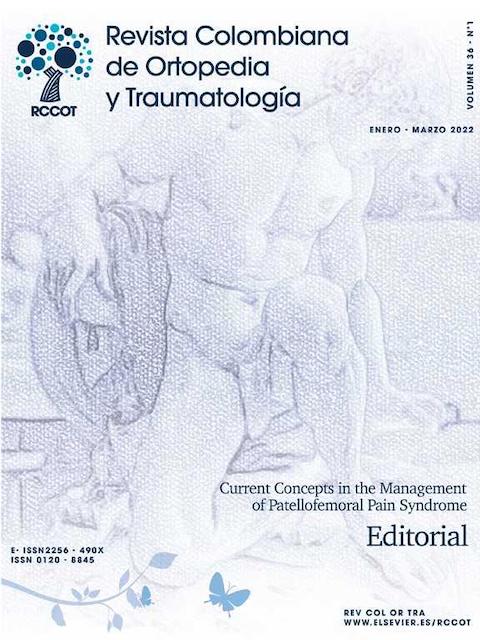The severe valgus knee: Total knee arthroplasty with a constrained prosthesis
DOI:
https://doi.org/10.1016/j.rccot.2022.04.004Keywords:
genu valgum, Joint instability, knee prosthesisAbstract
Purpose: This retrospective level 2 analysis evaluates the prosthesis type selected in our department for the treatment of the severe valgus knee and proposes a new classification for the valgus knee osteoarthritis.
Material and methods: A total knee arthroplasty with a constrained or hinged knee prosthesis was performed in 28 valgus knees. The average follow-up was 6.2 years. A new classification that considerates the ligament sufficiency status was developed in order to relate the different knee types with the different type of eventually needed implants.
Results: Constrained prosthesis was used in 17 patients with an attenuated medial collateral ligament, and a rotating hinge in 11 patients with incompetent medial collateral ligament and/or recurvatum. The postoperatory Knee Society Score was of 85 points. The valgus knee was classified in 5 types considering the knee valgus deformity, the ligament sufficiency and joint stability and wear.
Discussion: The classification proposed clearly defines the ligament status and valgus knee types, and it seems to be a comprehensive tool to select the appropriate prosthesis. Constrained prosthesis must be used on patients who present coronal instability with attenuated medial collateral ligament. Rotating hinges must be reserved for those patients who have medial collateral ligament incompetence, recurvatum, combined instability and/or severe muscular deficiency.
Level 3 of evidence.
Downloads
References
Naudie D, Rorabeck C. Managing instability in total knee arthroplasty with constrained and linked implants. AAOS Instructional Course Lectures. 2004;53:207-15.
Vedoya S, Garabano G, del Sel H. Indicación y resultados de la prótesis con estabilidad aumentada en la artroplastia primaria de rodilla. Rev. Asoc. Argent. Ortop. Traumatol. 2018;83:94-100.
Girard J, Amzalag R. Total knee arthroplasty in valgus knees: Predictive preoperative parameters influencing a constrained design selection. Orthopaedics & Traumatology: Surgery & Research. 2009;95:260-6.
Ranawat CS, Rose HA, Rich DS. Total condylar knee arthroplasty for valgus and combined valgus flexion deformity of the knee. Instr Course Lect. 1984;33:412-6.
Krackow K, Jones M, Teeny S, Hungerford D. Primary total knee arthroplasty in patients with fixed valgus deformity. Clin Orthop Relat Res. 1991;273:9-18.
Krackow K, Mihalko W. Flexion-extension joint gap changes after lateral structure release for valgus deformity correction in total knee arthroplasty: a cadaveric study. J Arthroplasty. 1999;14:994-1004.
Krackow K. The technique of total knee arthroplasty. St Louis: Mosby-Year Book;. 1990:352-9.
Ranawat A, Ranawat C, Elkus M, Rasquinha V, Rossi R, Babhulkar S. Total knee arthroplasty for severe valgus deformity. Surgical technique. J Bone Joint Surg Am. 2005;87:271-84.
Miyasaka KC, Ranawat CS, Mullaji A. 10- to 20-year follow up of total knee arthroplasty for valgus deformities. Clin Orthop. 1997;345:29-37.
Lachiewicz PF, Soileau ES. Ten-year survival and clinical results of constrained components in primary total knee arthroplasty. J Arthroplasty. 2006;21-6:803-8.
Lombardi A, Berend K. Posterior-Stabilized Constrained Total Knee Arthroplasty for Complex Primary Cases. JBJS. 2007;89A:90-102.
Kim YH, Kim JS. Revision Total Knee Arthroplasty with Use of a Constrained Condylar Knee Prosthesis. JBJS. 2009;91A:1440-7.
Hartford JM, Goodman SB, Schurman DJ, Knoblick G. Complex primary and revision total knee arthroplasty using the constrained condylar prosthesis: an average 5-year follow up. J Arthroplasty. 1998;13:380-7.
Springer BD, Hanssen AD, Sim FH, Lewallen DG. The kinematic rotating hinge prosthesis for complex knee arthroplasty. Clin Orthop. 2001;392:283-91.
Hernandez Vaquero D, Sandoval Garcia M. Hinged total knee arthroplasty in presence of ligamentous deficiency. Clin Orthop Relat Res. 2010;468:1248-53.
Yang JH, Yoon JR, Oh CH, Kim TS. Primary total knee arthroplasty using rotating-hinge prosthesis in severely affected knees. Knee Surg Sports Traumatol Arthrosc. 2012;20:517-23.
Anderson JA, Baldini A, MacDonald JH, Tomek I, Pellicci PM, Sculco TP. Constrained condylar knee without stem extensions for difficult primary total knee arthroplasty. J Knee Surg. 2007;20:195-8.
Lachiewicz PF, Soileau ES. Results of second-generation constrained condilar prosthesis in primary total knee arthroplasty. J Arthroplasty. 2011;26-8:1228-31.
Pour AE, Parvizi J, Slenker N, Purtill JJ, Sharkey PF. Rotating hinged total knee replacement: use with caution. J Bone Joint Surg. 2007;89A:1735-41.
Kowalczewski J, Marczak D, Synder M, Sibinski M. Primary rotating-hinge total knee arthroplasty: good outcomes at midterm follow-up. Journ Arthrop. 2014;29:1202-6.
Gehrke T, Kendoff D, Haasper C. The role of hinges in primary total knee replacement. J Bone Joint Surg. 2014;96B-11:93-5.
Puloski SK, McCalden RW, MacDonald SJ, et al. Tibial post wear in posterior stabilized total knee arthroplasty: an unrecognized source of polyethylene debris. J Bone Joint Surg. 2001;83A:390-5.
Ewald FC. The Knee Society total knee arthroplasty roentgenographic evaluation and scoring system. Clin Orthop. 1989;248:9-12.
Insall JN, Dorr LD, Scott RD, Scott WN. Rationale of the Knee Society clinical rating system. Clin Orthop Relat Res. 1989;248:13-4.
Kim YH, Kim JS, Oh SW. Total knee arthroplasty in neuropathic arthropathy. J Bone Joint Surg. 2002;84B:216-21.
Favorito PJ, Mihalko WM, Krackow KA. Total knee arthroplasty in the valgus knee. J Am Acad Orthop Surg. 2002;10:16-24.
Petrou G, Petrou H, Tilkeridis C, Stavrakis T, Kapetsis, Kremmidas N, Gavras M. Medium-term results with a primary cemented rotating-hinge total knee replacement. A 7 to 15 year follow-up. J Bone Joint Surg. 2004;86B-6:813-7.
Maynard LM, Sauber TJ, Kostopulos VK, Lavinge GS, Sewecke JJ, Sotereanos NG. Survival of primary condilar-contrained total knee arthroplasty at mínimum of 7 years. J of Arthroplasty. 2014;29:1197-201.
Cottino U, Abdel M, Perry M, Mara K. Long-Term Results After Total Knee Arthroplasty with Contemporary Rotating-Hinge Prostheses. J Bone Joint Surg Am. 2017;99:324-30.
Bistolfi A, Lustig S, Rosso F, Dalmasso P, Crova M, Massazza G. Results with 98 Endo-modell Rotating Hinge prosthesis for primary Knee Arthroplasty. Othopedics. 2013;36-6:747-52.
Vedoya S, Garabano G, del Sel H. Gonartrosis asociada a deformidad extrarticular: Indicaciones de prótesis de rodilla. Revista Latinoamericana de Cirugía Ortopédica. 2017;2(7.).





